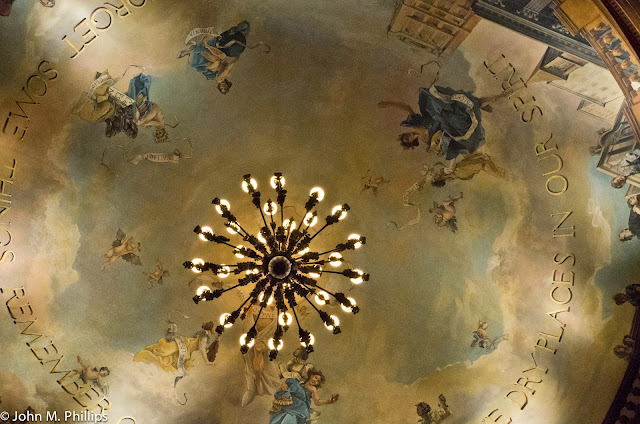Two of the locations I was most interested in visiting and getting photos of were the Pabst Theater and the Skylight Theatre. I have to admit that, in the end, I was a bit disappointed in what I was able to shoot in each.
I visited the Skylight Theatre on Saturday, the 22nd. I have had some personal history with the Skylight. Early in my career I handled the estate of Mildred Lindsay, who was a major benefactress of the Skylight. She had owned the property where the theater was housed at the time of her death in 1979, a converted garage in downtown Milwaukee. She was also a good friend of Clair Richardson, the individual most important to the founding of the theater company in 1959, and set up a trust for him at her death that I administered briefly until his premature death in 1980. Twenty-some years ago the Skylight, along with a couple of other theater companies acquired property in Milwaukee's Third Ward and converted it into a gorgeous theater space, and the Skylight has been there ever since. The theater seats about 350 but feels much more intimate, I think because of the way the multiple balconies are structured. The Skylight's ceiling is of special interest as it appears to be domed and has been hand-painted with various characters that were important to Milwaukee's political and cultural scene. I thought the Doors Open event would provide me with a special opportunity to capture some of that beauty. Not so easy.
First, the lighting in the theater was very low, requiring that I push the ISO up substantially. Most of the shots were taken at an ISO of 2000 to 4000. Second, because the space is so intimate and includes not just the ceiling but the sides and stage, capturing this requires a true wide-angle shot, and I simply do not have the equipment (yet) to do that.
Here is a shot of the area above the stage that includes a portion of the ceiling.
And here is an attempt to photograph the ceiling.
Not great, as I could not get the entire ceiling in the photo. One comment about the ceiling. When I entered the theater, a docent for the event asked if I was familiar with the theater and particularly with the domed ceiling. I said that I was and that actually the ceiling only appeared to be domed; it was actually flat. I said that the illusion was a good one but that you could see that the ceiling was flat by visiting the upper balconies. She replied that she had been ushering at the theater for 16 years but had never known before that the ceiling was not domed. Later, while I was trying to get shots of the theater, she remarked to some other visitors that the ceiling appeared domed but was actually flat and that she had learned this from "the gentleman taking pictures." Unfortunately, I was not able to capture the dome illusion in these shots.
Here are a couple of shots in which I tried to give a flavor of the role that the balconies play.
I also thought it might be interesting to take some shots of the seating patterns.
Not great, but I also took a few shots from the rear of the auditorium of the backs of the seats. I liked these a lot better, probably because of their abstract quality.
The Pabst Theater is located in downtown Milwaukee, and I visited it on Sunday, the 23rd. The Pabst has a much longer history than the Skylight. The current theater initially opened in 1895 and is the country's fourth oldest continuously operating theater. It has a seating capacity of 1,350, about four times the size of the Skylight. It hosts a wide range of live performing arts acts from individual musical performers to ensemble-cast theater productions. In 1976, after a long decline, the theater underwent a major renovation and now is considered one of the premiere theater venues in the city. In 1989 it became part of a larger complex that includes the three venues of the Milwaukee Repertory Theater, as well as an office tower and hotel and restaurant.
I had passed by the theater on Saturday, the 22nd, and had taken a few exterior shots in the brilliant sunlight.
It was a different story on my visit to the interior on Sunday. Again, the light was very low. Also there were great numbers of other visitors. Finally, my lack of a true wide-angle lens made capturing the space very difficult, despite its larger size. Here is an attempt at shooting the balcony areas.
And here is a photo of the main floor seating.
Visitors were allowed up on the stage and could view the inner workings of the theater. Here is a shot of that area.
I actually liked this shot.
The auditorium features a two-ton chandelier, and here a a couple of shots of that feature.
A word about these photos. The first was taken from directly below the chandelier and includes some shadows created by lighting from the side. The second was originally significantly underexposed, and I had to ramp the exposure up considerably in post-processing. I kind of like the effect.
Here, finally, is a shot that features some curved lines from the balconies that I thought worked out OK.
Taken with my Nikon D7000 with Nikkor 24-120 mm f/4 lens.



























































